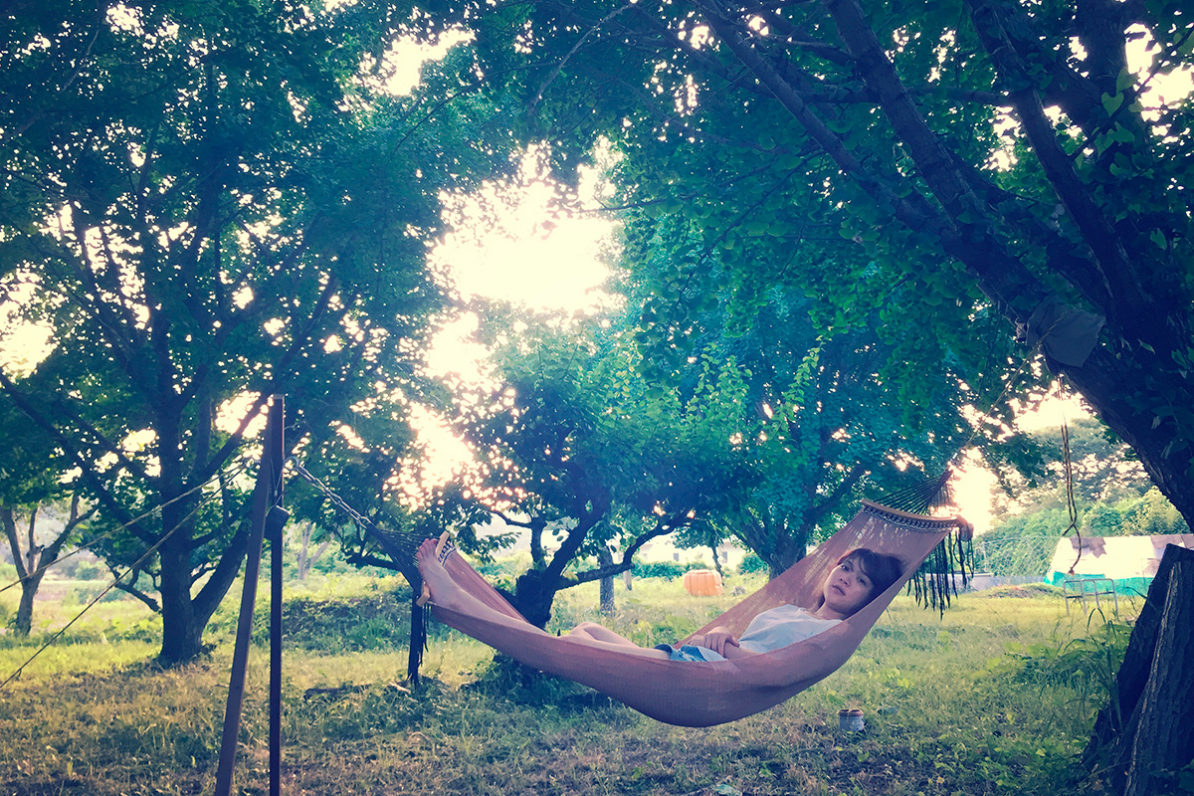There is not much sense in writing too much about Manga Jima director Moriya Fumio’s latest feature. What he has intended and by all accounts succeeded to accomplish is quite different from any yardstick used to measure movies. There will surely be discussions questioning those intentions and debating its accomplishments. Moriya more than anyone understands the gauntlet he has thrown down for himself as a filmmaker and to the audience who views it which is why he has self-labelled it a “controversial work”. But whatever you think those words mean can not prepare you for what you actually experience.
A Girl Under A Tree is two things. First, it is a still life. It recalls Georges Seurat’s pointillist masterpiece ‘A Sunday on La Grende Jatte’ with the vivid details of its outdoor setting. All manner of shades of green interplay with one another as sunlight backlights and shades the flora around actress Yanagi Elisa (Rolling, Ping Pang, Capturing Dad). There are patterns and textures throughout and fine detail revealed through closer, focused viewing. Yanagi herself would seem at home within Edouard Manet’s ‘The Luncheon on the Grass’ as an equally gentle, understated portrait of a girl lounging on a hammock; even more so whenever Yanagi breaks the fourth wall just as the foreground figure of Manet’s painting. However, this is also a motion picture and therefore it changes as time progresses. The subject moves, changes her pose, and there are layered soundscapes to be enjoyed in that way cinema differs from painting. Listen for the sounds of life going on around her as well as a subtle soundtrack which meanders its way throughout the runtime.
Second, the movie is a meditation. Not on any particular subject matter per se, but the movie itself is the meditation. In that sense, it is likely to reveal much about its audience. Who stays. Who leaves. Who finds value in it. Who dismisses it. Who loses themselves to its world. Who rails against it. When Yanagi breaks the fourth wall, what do they see in her gaze or expression? Do they look back? Or do they look elsewhere to avoid that gaze? The movie affords the audience 90 minutes in real-time to spend with Yanagi and see, hear, and possibly feel everything she does. Perhaps more. Moriya leaves whatever is gained from the experience completely up to the viewer. As one, little green sage once advised, what you find there is “only what you take with you.”
Perhaps before COVID-19, Moriya’s movie may have been panned as a self-indulgent exercise. But as people slowly come out from (continue to) quarantine or are still dealing with life mostly cooped up at home, A Girl Under A Tree could redefine “escapism” in a New Normal movie-going experience. Within those darkened spaces reduced in seating capacity, its calming window onto organic scenery and sound beckons the audience to daydream, to momentarily forget the anxieties of the past months and/or the future. This is theater-quality ASMR (Autonomous Sensory Meridian Response). Therefore, it is safe to say participating with this movie in a theatrical or similar setting is most likely what Moriya truly intends. A Girl Under A Tree is one of those cinema experiences only an independent film can provide and Moriya should be lauded for not only daring to make it, but to actually realize it with aplomb.
Notes on the Margin
– Though a single take, the movie took two days to shoot.
– Moriya and Yanagi had to agree upon ways to communicate as Moriya obviously could not bark out direction to her. More importantly they needed to confirm beforehand the signal for the two times Moriya wanted Yanagi to move. Though he had an image in his head, he fumbled to express what needed to happen afterward resulting in Yanagi perhaps not fully grasping what he wanted for the movie.
– On the first take of the first day, Moriya and the cinematographer noted their camera positioning captured Yanagi too small within the frame. The re-setup cost them 50 minutes and the second take began later than intended, costing them sunlight toward the later section. It was at this point Moriya gave Yanagi direction to look toward the camera and be conscious of the audience beyond.
– The morning of day two, Yanagi emerged smiling from a nearby onsen and told Moriya, “I understand”. He assumed she “understood” what he intended for the movie or perhaps the direction to engage with the audience, but he wasn’t sure how she came to that understanding given the previous day’s occurrences. All that he knew is her face was different that day and he wanted to be on set as soon as possible.
– The first take of the second day started at 3pm. Yanagi hardly moved. Before long she took Moriya’s cue and sat up and just as if they designed it, a breeze blew and rustled the trees. Yanagi’s movements were exactly as Moriya hoped to see indicating she truly did understand what he intended. During the take the sunlight darkened behind clouds so he decided to let the take continue but keep it for additional material.
– Before take two, they readjusted the position of the hammock due to the time of day. Cinematographer Takagi Fuuta said by doing so the sun would come into frame. A check of the monitor showed Yanagi with warm edge lighting giving the scene a floating feeling. That is when they took the still for the poster.
– Take two started at 4:50pm. This time Moriya left the timing to look toward the camera completely up to Yanagi. As predicted, the sun’s movement put it in a direct line with the camera lens and the image slowly began to blowout (turn white or overexposed). Moriya turned toward Takagi to ask if this was a problem, but found Takagi instead delighted by what he was witnessing.
